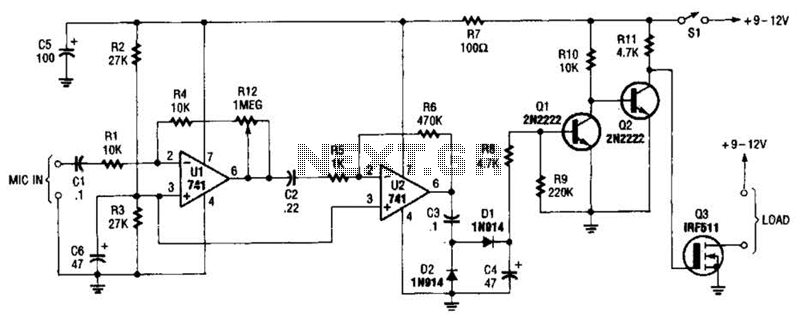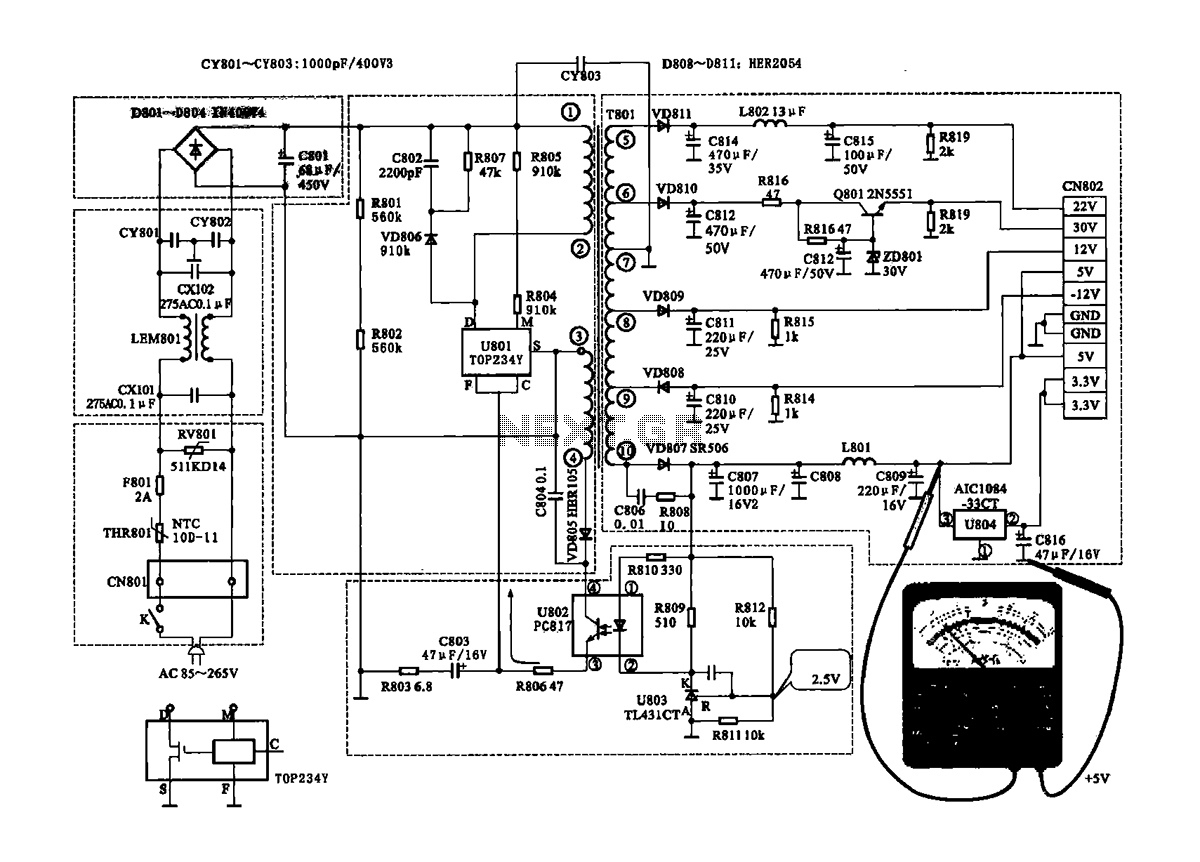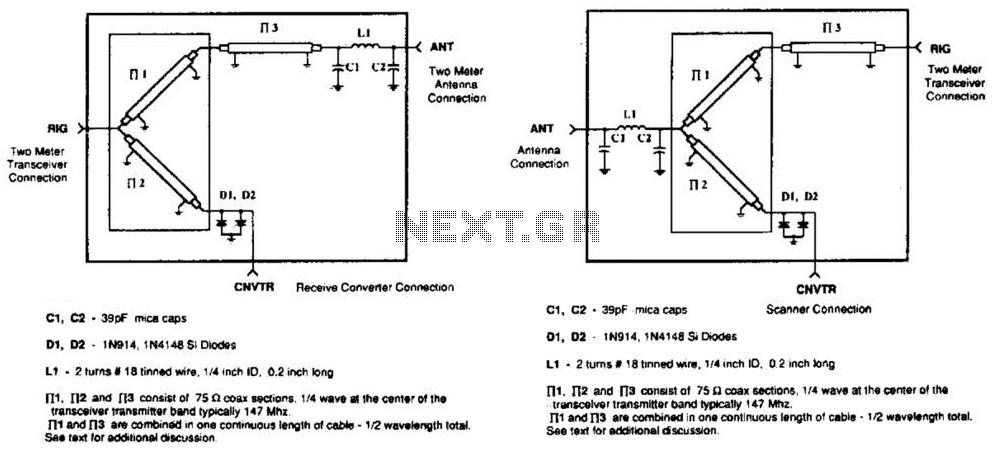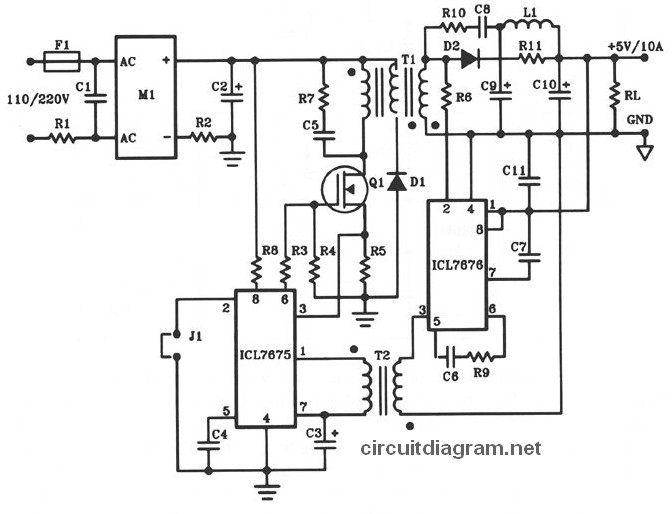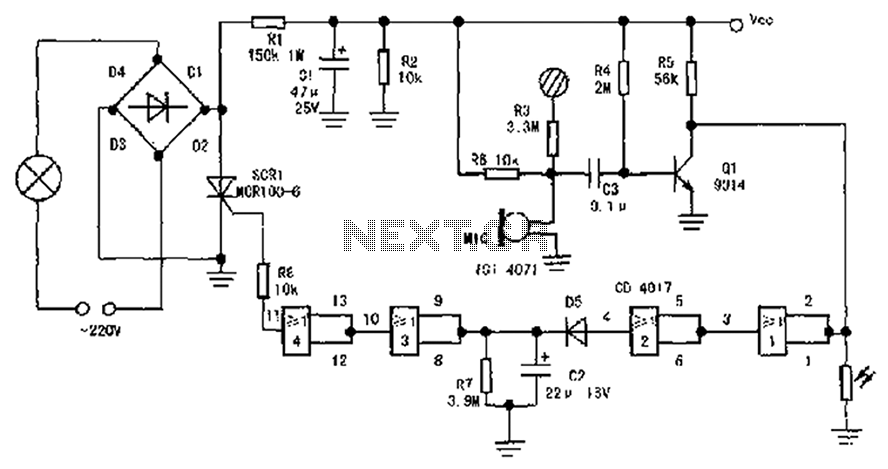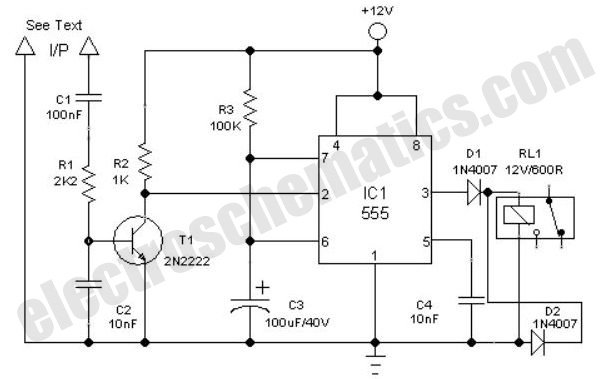
Keypad-Operated Switch No.2
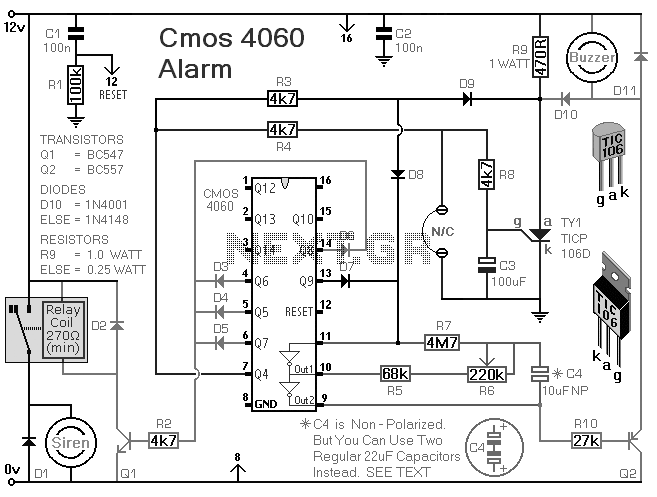
This is a simplified version of the Universal Keypad-Operated Switch. The design has been modified to reduce circuit complexity and the number of components required. As a result, the code is somewhat less secure; however, it remains adequate for many situations. The circuit is designed for a 12-volt supply but will operate within a range of 5 to 15 volts. It is essential to select a relay compatible with the desired supply voltage. If necessary, the SPCO/SPDT relay can be replaced with a multi-pole relay to suit specific applications. It is crucial not to use the onboard relay to switch mains voltage due to insufficient isolation between the relay contacts and low-voltage components. For mains voltage switching, a suitably rated relay should be mounted safely away from the board. The user must choose four keys to use as the code, connecting them to terminals A, B, C, and D, while wiring the common to R1 and all remaining keys to E. Upon powering up, the relay will be energized. To de-energize it, the correct code must be entered, and to re-energize, any key connected to E can be pressed. To reverse the circuit operation, replace Q2 with a BC547 transistor. With an NPN transistor in this position, the circuit will power up with the relay de-energized, requiring the correct code to energize it, and pressing any key connected to E will de-energize it again. Any keys not connected to A, B, C, or D will connect to the base of Q1. If a "wrong" key is pressed, Q1 will pull pin 1 low, causing the code entry sequence to fail. In case of a mistake during code entry, the user can simply start over. The keypad must feature a common terminal with separate connections for each key. A 12-key pad should have 13 terminals, as matrix types with 7 or 8 terminals are not suitable. A 12-key pad includes eight "wrong" keys connected to E. For enhanced security, a larger keypad with more "wrong" keys can be utilized. Supporting materials for this circuit include a step-by-step guide for constructing the circuit board, a parts list, and a detailed circuit description.
The Universal Keypad-Operated Switch circuit is designed to provide a user-friendly interface for controlling devices via a keypad input. The circuit operates on a voltage range of 5 to 15 volts, allowing for flexibility in power supply selection. The choice of relay is critical, as it must match the supply voltage, and if higher power devices need to be controlled, a multi-pole relay can be integrated for enhanced functionality.
The circuit’s operation begins with the relay being energized at power-up. The user must input a specific sequence of four keys connected to terminals A, B, C, and D to de-energize the relay. The common terminal is connected to R1, while all other keys are routed to terminal E. Pressing any of the keys connected to E will re-energize the relay, providing a straightforward method for resetting the circuit state.
For applications requiring reversed operation, substituting Q2 with a BC547 NPN transistor alters the default state of the relay to de-energized upon power-up. This modification allows the circuit to function in a manner where the user must enter the code to activate the relay, enhancing its utility in various scenarios.
Incorporating a keypad with a common terminal and individual connections for each key is essential for the circuit's operation. A standard 12-key keypad should provide 13 terminals, ensuring compatibility with the circuit design. The inclusion of eight "wrong" keys connected to E serves as a deterrent against unauthorized access, and utilizing a larger keypad with additional "wrong" keys can further enhance security measures.
Overall, the Universal Keypad-Operated Switch circuit is a versatile solution for controlling electronic devices, with a focus on simplicity and functionality while maintaining a level of security appropriate for many applications. Supporting documentation, including construction guides and parts lists, facilitates the assembly and implementation of this circuit in practical applications.This is a simplified version of the Universal Keypad-Operated Switch. I have modified the design to reduce the complexity of the circuit - and the number of components required. As a result - the code is somewhat less secure. However, there should be lots of situations where it will still be adequate. The circuit is drawn with a 12-volt supply - b ut it will work at anything from 5 to 15-volts. All you have to do is choose a relay suitable for the supply voltage you want to use. Replace the SPCO/SPDT relay with a multi-pole relay - if it suits your application. Do not use the "on-board" relay to switch mains voltage. The board`s layout does not offer sufficient isolation between the relay contacts and the low-voltage components. If you want to switch mains voltage - mount a suitably rated relay somewhere safe - Away From The Board.
Choose the four keys you want to use as your Code - and connect them to "A B C & D". Wire the common to R1 and all the remaining keys to "E". The circuit will power-up with the relay energized. To de-energize it - you must enter your code. To re-energize it - press any of the keys connected to "E". To reverse the operation of the circuit replace Q2 with a BC547. With an NPN transistor in this position - the circuit will power-up with the relay de-energized. To energize it - you must enter your code. To de-energize it again - press any of the keys connected to "E". Any keys not wired to "A B C & D" are connected to the base of Q1. Whenever one of these "Wrong" keys is pressed - Q1 takes pin 1 low and the code entry sequence fails. If you make a mistake while entering the code - simply start again. The Keypad must be the kind with a common terminal and a separate connection for each key. On a 12-key pad, look for 13 terminals. The matrix type with 7 or 8 terminals will NOT do. A 12-key pad has eight "Wrong" keys connected to "E". If you need a more secure code - use a bigger keypad with more "Wrong" keys. The Support Material for this circuit includes a step-by-step guide to the construction of the circuit board, a parts list, a detailed circuit description and more.
🔗 External reference
The Universal Keypad-Operated Switch circuit is designed to provide a user-friendly interface for controlling devices via a keypad input. The circuit operates on a voltage range of 5 to 15 volts, allowing for flexibility in power supply selection. The choice of relay is critical, as it must match the supply voltage, and if higher power devices need to be controlled, a multi-pole relay can be integrated for enhanced functionality.
The circuit’s operation begins with the relay being energized at power-up. The user must input a specific sequence of four keys connected to terminals A, B, C, and D to de-energize the relay. The common terminal is connected to R1, while all other keys are routed to terminal E. Pressing any of the keys connected to E will re-energize the relay, providing a straightforward method for resetting the circuit state.
For applications requiring reversed operation, substituting Q2 with a BC547 NPN transistor alters the default state of the relay to de-energized upon power-up. This modification allows the circuit to function in a manner where the user must enter the code to activate the relay, enhancing its utility in various scenarios.
Incorporating a keypad with a common terminal and individual connections for each key is essential for the circuit's operation. A standard 12-key keypad should provide 13 terminals, ensuring compatibility with the circuit design. The inclusion of eight "wrong" keys connected to E serves as a deterrent against unauthorized access, and utilizing a larger keypad with additional "wrong" keys can further enhance security measures.
Overall, the Universal Keypad-Operated Switch circuit is a versatile solution for controlling electronic devices, with a focus on simplicity and functionality while maintaining a level of security appropriate for many applications. Supporting documentation, including construction guides and parts lists, facilitates the assembly and implementation of this circuit in practical applications.This is a simplified version of the Universal Keypad-Operated Switch. I have modified the design to reduce the complexity of the circuit - and the number of components required. As a result - the code is somewhat less secure. However, there should be lots of situations where it will still be adequate. The circuit is drawn with a 12-volt supply - b ut it will work at anything from 5 to 15-volts. All you have to do is choose a relay suitable for the supply voltage you want to use. Replace the SPCO/SPDT relay with a multi-pole relay - if it suits your application. Do not use the "on-board" relay to switch mains voltage. The board`s layout does not offer sufficient isolation between the relay contacts and the low-voltage components. If you want to switch mains voltage - mount a suitably rated relay somewhere safe - Away From The Board.
Choose the four keys you want to use as your Code - and connect them to "A B C & D". Wire the common to R1 and all the remaining keys to "E". The circuit will power-up with the relay energized. To de-energize it - you must enter your code. To re-energize it - press any of the keys connected to "E". To reverse the operation of the circuit replace Q2 with a BC547. With an NPN transistor in this position - the circuit will power-up with the relay de-energized. To energize it - you must enter your code. To de-energize it again - press any of the keys connected to "E". Any keys not wired to "A B C & D" are connected to the base of Q1. Whenever one of these "Wrong" keys is pressed - Q1 takes pin 1 low and the code entry sequence fails. If you make a mistake while entering the code - simply start again. The Keypad must be the kind with a common terminal and a separate connection for each key. On a 12-key pad, look for 13 terminals. The matrix type with 7 or 8 terminals will NOT do. A 12-key pad has eight "Wrong" keys connected to "E". If you need a more secure code - use a bigger keypad with more "Wrong" keys. The Support Material for this circuit includes a step-by-step guide to the construction of the circuit board, a parts list, a detailed circuit description and more.
🔗 External reference
